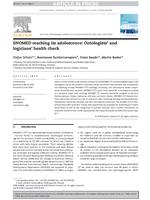SNOMED reaching its adolescence: Ontologists' and logicians' health check
From International Center for Computational Logic
SNOMED reaching its adolescence: Ontologists' and logicians' health check
Stefan SchulzStefan Schulz, Boontawee SuntisrivarapornBoontawee Suntisrivaraporn, Franz BaaderFranz Baader, Martin BoekerMartin Boeker
Stefan Schulz, Boontawee Suntisrivaraporn, Franz Baader, Martin Boeker
SNOMED reaching its adolescence: Ontologists' and logicians' health check
International Journal of Medical Informatics, 78(Supplement 1):S86-S94, 2009
SNOMED reaching its adolescence: Ontologists' and logicians' health check
International Journal of Medical Informatics, 78(Supplement 1):S86-S94, 2009
- KurzfassungAbstract
After a critical review of the present architecture of SNOMED CT, addressing both logical and ontological issues, we present a roadmap toward an overall improvement and recommend the following actions: SNOMED CT's ontology, dictionary, and information model components should be kept separate. SNOMED CT's upper level should be re-arranged according to a standard upper level ontology. SNOMED CT concepts should be assigned to the four disjoint groups: classes, instances, relations, and meta-classes. SNOMED CT's binary relations should be reduced to a set of canonical ones, following existing recommendations. Taxonomies should be cleansed and split into disjoint partitions. The number of full definitions should be increased. Finally, new approaches are proposed for modeling part-whole hierarchies, as well as the integration of qualifier relations into a unified framework. All proposed modifications can be expressed by the computationally tractable description logic EL++. - Forschungsgruppe:Research Group: AutomatentheorieAutomata Theory
@article{ SchEtAl-JMI-09,
author = {Stefan {Schulz} and Boontawee {Suntisrivaraporn} and Franz {Baader} and Martin {Boeker}},
journal = {International Journal of Medical Informatics},
number = {Supplement 1},
pages = {S86--S94},
publisher = {Elsevier},
title = {{SNOMED} reaching its adolescence: Ontologists' and logicians' health check},
volume = {78},
year = {2009},
}
